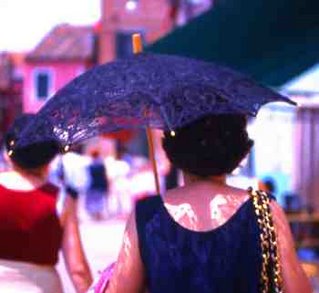
Gleaming mahogany boats flying like polished arrows across the Adriatic; a crayon-colored village of narrow, wild-hued houses; ladies promenading under handmade lace umbrellas; carafes of cool white wine. And love.
At Venice’s San Zaccaria vaporetto stop, not far from the Piazza San Marco, we’d boarded the public water taxi that took us across the Venetian lagoon and dropped us an hour later at the island of Burano. Once on the water, Mike and I spent the ride soaking up sun and watching Venetians at play in the lagoon while the kids spied on two twentysomethings smooching near the boat’s stern.
The lagoon was the scene of a great, waterborne, weekend tailgate party. While sleek, wooden boats captained and mated by beautiful bronzed people, the most buxom of whom decorated the bows, zipped about on see-and-be-seen missions, more pedestrian craft had anchored and tethered themselves together in the shallows along the lagoon’s reedy shores. The boats were tied in star-shaped clusters to facilitate boat-hopping, and people ate and drank, laugh and kissed, massaged lotion into each others’ backs, danced, preened, posed and flexed. Some had pitched nylon cabanas and bright umbrellas on nearby sandbars.
“The Leaning Tower of Cheese-a!” yelled Dana as we approached Burano, pointing to the island’s listing campanile. The green island of Torcello floated in the haze to our right, and the straight-up erectness of its bell tower intensified the gravity-defying tilt of Burano’s.
Burano bursts with houses painted in brilliant shades of purple, blue, red, orange, yellow, green. A giant Crayola box, lid invitingly up. Every street is a rich palette of bold colors.
After an al fresco lunch of pasta and frutti di mare in sweet marinara, we walked Burano’s main street, wide, cobbled, and built aside the canal that flows through town. Villagers’ boats lined both sides of the canal. Most sported bright Burano paint jobs. Leftover house paint.
I noticed a flier taped to the window of a tiny sandwich shop. Two fresh faces smiled from the poster, which read, “Walter & Paola oggi Sposi – Walter and Paola to marry today.” Cheek to cheek, the couple announced their love to all of Burano. I hoped they’d put the poster up that morning. Then, “oggi” would mean “today” literally, not just in translation. Perhaps we’d see a wedding.
We headed to the broad central piazza that holds Burano’s medieval church. The crooked campanile leaned like a loose tree limb over our heads, but, as it hadn’t toppled into the square after three centuries, we bet we’d beat the odds and let the kids race each other around its massive brick base.
As Adam and Dana roughhoused about the bell tower, spiffily polished people dressed to the nines began filling the piazza. We smelled nuptials. We were going to see Paola marry Walter.
The women carried graceful lace umbrellas that shielded their creamy faces from the sun. Burano lace is prized, and each exquisite umbrella – bright white or velvety black – was a work of art. As the women milled about and talked, I darted between them, photographing their umbrellas’ intricate, sun-lit patterns.
Just before noon, Paola appeared. The crowd in the piazza formed a hushed horseshoe as the bride glided up Burano’s cobbled main street on her beaming father’s arm. The train of Paola’s ivory wedding dress rustled over the paving stones as she made her way to the church door. There, her father lifted her veil, kissed her, then held her at arm’s length and smiled into her eyes. The wedding party and guests entered the church.
We stood on tiptoes and watched the ceremony through the church window. As Wagner’s Wedding March thundered from the organ, filling Burano with sounds of joy, Paola floated up the aisle and joined Walter at the altar.
The crayon houses seemed to break into smiles.
Ribbons -- happiness guaranteed
